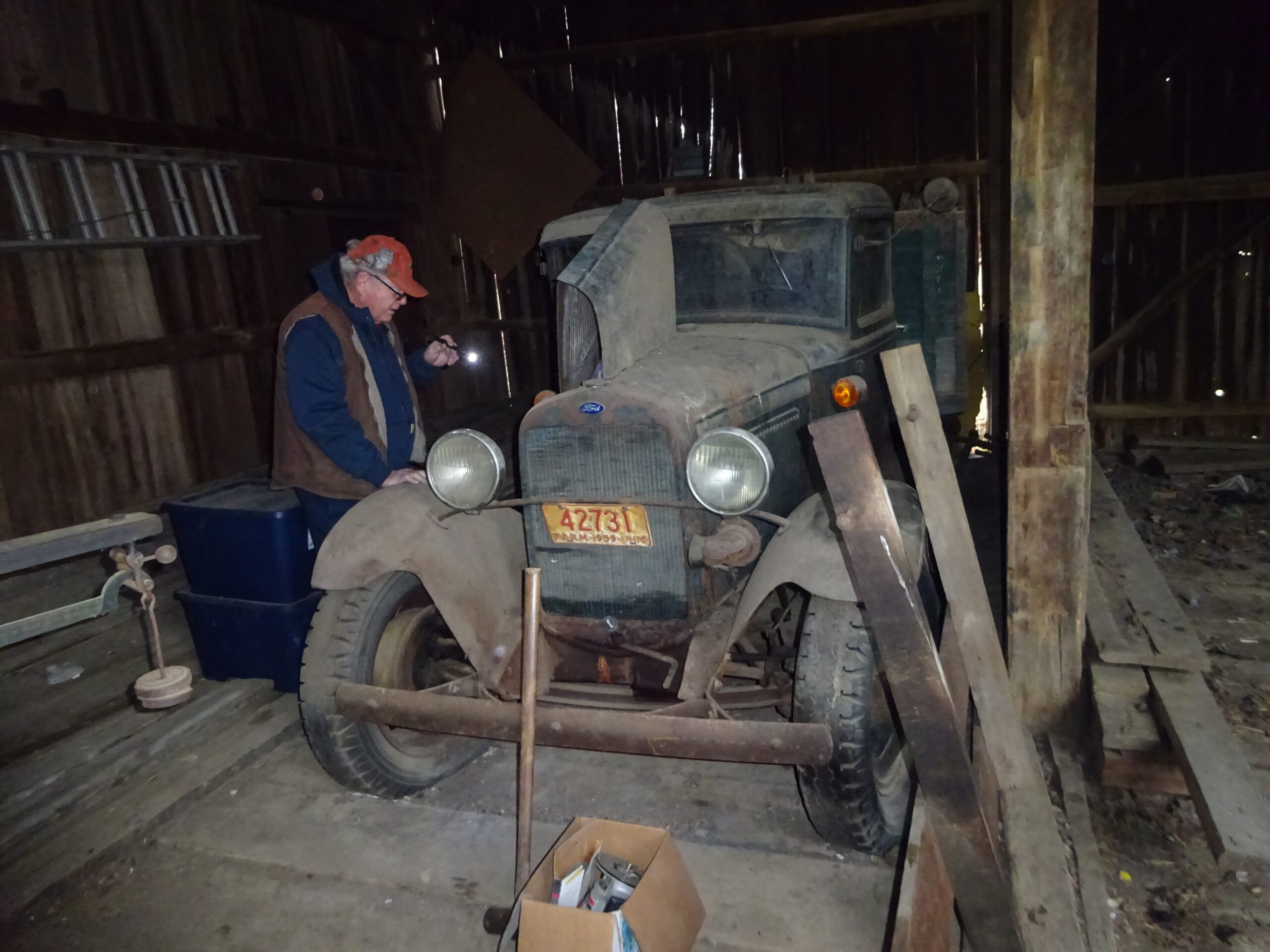Oh gosh Henrietta, something is going on in the barn again. The humans have opened up the barn doors, too much light, not used to all this light in this old barn. Get me my sunglasses! Sam, it’s that farmer guy lookin’ around in here. Oh boy, he’s brought two other humans in to look at our mobile home(decrepit Model AA Ford Farm Truck). Oh Lord, here we go. Sam, go walk out on the front axle and get a better look. Yep, here they come; they’re going to now open up the hood, take our roof off again. I hope they think to close it again. Now he’s going for the dipstick. Well, I believe that there was oil in it when it was parked 58 generations ago. But how many times have we peed in it? Now they’re trying to open up the cab doors. Good luck with that. Nothing to see in there. Our forefathers ate all the upholstery years ago.
Henrietta and Sam are the two light grey mice that came out of the engine bay to greet us when Jerry and I looked at a 1931 Ford Farm truck right before New Years Eve. Henrietta was perched on the left brake drum and Sam was on the front axle to the right. Once they scoped us out , they quickly left the scene for the bowels of the truck. After one look at the truck I said to the mice,” don’t worry guys, we’re not taking this one!” Jerry and I travelled to Milan, Ohio to look at this truck. A tip given to us by a Model “T” friend noted that it is a commercial, AA Ford farm truck that is a good bit bigger than a pickup truck. Engine and transmission wise it is mechanically the same as the venerable Model “A” Fords. But the axles, wheels, rear end, gearing, as well as the frame, are all exclusive to the big trucks. While a great many were produced over the four year span of the Model “A”s production, very few remain because they were quite frankly worked to death through the depression and World War II. While they can be restored, the market for these commercial trucks is quite limited, and consequently they are not worth a great deal of money. The cars are always worth more. Parts are scarce and reproduction parts are often three times and more as expensive as car parts. But when you get a tip, it’s always better to follow up on it because something else might be lurking in that barn.
This truck that we went to look at was definitely worked to death before it was put in the barn wet. Some pictures that were sent to us indicated a much more viable truck than what was in front of us and had we known that in advance, we would not have bothered even looking at it. The asking price was $4500. Picture often lie and present things in a better light than what actually is. A 1957 license plate hints at the last time it likely ran. When we opened up the hood, the mice ran for parts unknown. Everything was so rusted that we didn’t even try to turn it over. The extremely large commercial tires were balder than me and flat—all four of them. There should have been dual wheels on the back but there was not. The inside of the cab was, well, there were shreds of a burlap bag on the seat springs. Not much more to be said there. The soft roof was hanging down in tatters. The inside of the cab was totally rusted. The gas tank showed signs of long ago leaking profusely. The front fenders were dented, rusted out and split open in places. The other thing we noticed was that there was obviously a family of raccoons living in the truck. There were raccoon feces everywhere. Jerry said a couple time, “They’d have to pay me to take this thing away. I admonished him, “Don’t say that out loud. They might take us up on that.”
Now I have seen Jerry resurrect worse cases than this, but we have learned over the years that buying junk to restore just so you can say that you did it, is not the way to go. Beside the thousands of hours you would have invested in this pile of truck junk the financial considerations are astounding. At best the running, rolling truck might be worth 15K. You would very quickly have three times that amount invested and this would only be a rolling runner, not a show truck. Tires and wheels alone would run you 3K minimum. A rebuild of the engine and transmission and clutch would be 4-5K, brakes and drums easily 4-5K, gas tank, fenders and body parts 5K, radiator 2-3K, Paint, glass, bodywork 5K. And these are just the obvious things that need replaced, repaired, addressed.
The other consideration that is very relevant to this truck is where it is parked and just how could you get it out of this barn. The barn was somewhat repaired in the last 50 years since the truck was parked. The door that the truck was driven through no longer exists. There are piles of old lumber stacked up next to the truck, all of which would have to be moved. The back of the truck would have to be dragged, winched sideways while the front of the truck simultaneously dragged forward, then dragged toward another wall, this to get it around the corner in the remodeled barn. Then it would have to be dragged, winched into position to be winched onto a car hauler after making a makeshift ramp to get it out of the barn. Whew! This would be a daunting task to say the least and would only likely happen if this was a rare, million dollar Mercedes Roadster, not a commercial truck. The barn is more likely to fall down first.
Rest assured Henrietta. Your mobile home is safe. And tell all the racoons that their half of the duplex is not likely to go anywhere soon.









